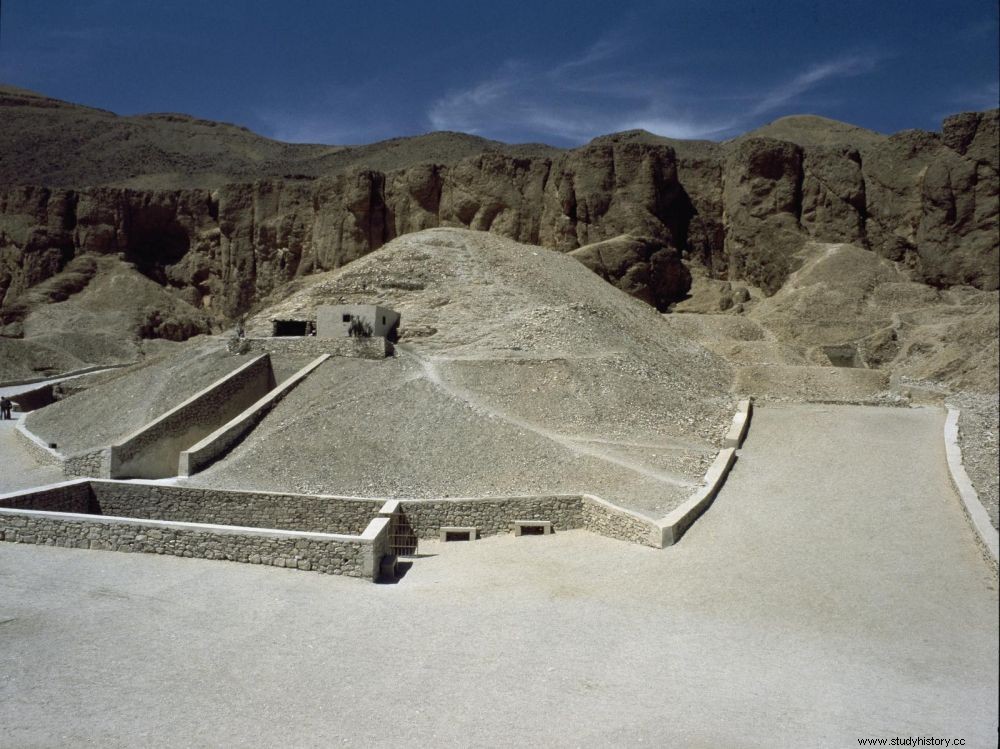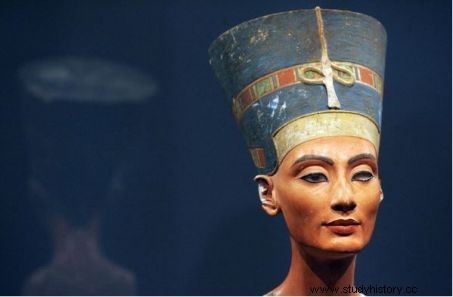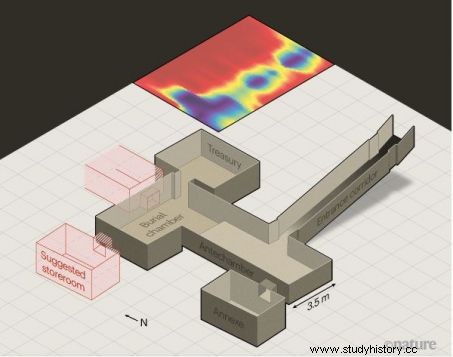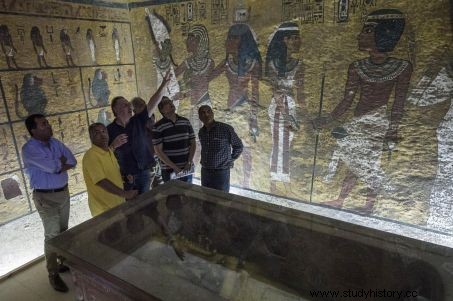Reported by Nature magazine , new analyzes carried out around the tomb of Tutankhamun in the Valley of the Kings in Egypt would relate the presence of possible "chambers" hidden behind its walls...

View of the tomb of Tutankhamun, in the Valley of the Kings, in Luxor, Egypt.
New twist in Egypt! Recent ground-penetrating radar analyzes have revived the trail of unsuspected cavities near the tomb of the famous pharaoh Tutankhamun (1332-1323 BC) in the Valley of the Kings in Luxor, Egypt. According to the prestigious journal Nature, these results would appear in an "unpublished report" to which she would have had access. Researchers led by Mamdouh Eldamaty, a former Egyptian minister of antiquities, reportedly used ground-penetrating radar (GPR) to scan an area immediately adjacent to the tomb, which revealed significant anomalies. Let "an unknown corridor type space a few meters from the burial chamber" . Findings presented to the Supreme Council of Egyptian Antiquities (SCA) in early February 2020.
The trail of Nefertiti?
The turbulent history of whether or not these secret cavities exist dates back to 2015, when British Egyptologist Nicholas Reeves of the University of Arizona (USA), former director of the Amarna Royal Tombs project, issued a hypothesis that immediately finds a wide echo:visible cracks in the painted walls of Tutankhamun's burial chamber would indicate, according to him, the presence of concealed accesses, which would conceal the tomb of an important figure of the 18th dynasty…and why not Queen Nefertiti herself!

Bust of Queen Nefertiti exhibited at the Neues Musuem in Berlin (Germany). Credits:Oliver Lang /DPP /AFP
Several geophysical surveys of infrared thermography first, then georadar (GRD) and electrical resistivity thomography (ERT) then, are immediately carried out in the royal cavity. In 2015, a first survey carried out by the Japanese physicist Hirokatsu Watanabe (now deceased) delivered very promising first results (GPR1). A second control expertise was then carried out in 2016 by an American team from National Geographic … which does not reach the same conclusions! A real cold shower for all the specialists who had taken to dreaming...
Anomalies detected around Tutankhamun's tomb by Terravision Exploration
A third team then embarked on a new investigation operation in 2018, led by Franco Porcelli, physicist at the Polytechnic University of Turin (Italy). Result:There are no hidden rooms behind the walls of the tomb. However, the Italian team is not the last to intervene. Terravision Exploration, a British geophysical survey company based in West Molesey (UK) obtains authorizations to carry out its own measurements… before being forced by the Supreme Council of Egyptian Antiquities (CSA) to interrupt its surveys. However, it turns out that the preliminary results of Terravision suggested, according to the journal Nature , that the walls could very well conceal unexplored cavities...
Hence the decision of Mamdouh Eldamaty, now a professor at Ain Shams University in Cairo, to ask the British company to resume its investigations. Recall that Mamdouh Eldamaty when he assumed the functions of Minister of Antiquities, supervised the first detections of Hirokatsu Watanabe. The SCA having approved this new request in June 2019, Terravision and a team of engineers from Ain Shams University were therefore able to complete the surveys.

The use of ground penetrating radar (GPR) would have recently revealed the presence of an unknown space (long corridor in blue), near the tomb of Tutankhamun, in the Valley of the Kings (Luxor) . In 2015, the British archaeologist Nicholas Reeves had proposed another location for pieces he considered hidden (here materialized in pink). Credits:Nature
New twist in Egypt! Recent ground-penetrating radar analyzes have revived the trail of unsuspected cavities near the tomb of the famous pharaoh Tutankhamun (1332-1323 BC) in the Valley of the Kings in Luxor, Egypt. According to the prestigious journal Nature, these results would appear in an "unpublished report" to which she would have had access. Researchers led by Mamdouh Eldamaty, a former Egyptian minister of antiquities, reportedly used ground-penetrating radar (GPR) to scan an area immediately adjacent to the tomb, which revealed significant anomalies. Let "an unknown corridor type space a few meters from the burial chamber" . Findings presented to the Supreme Council of Egyptian Antiquities (SCA) in early February 2020.
The trail of Nefertiti?
The turbulent history of whether or not these secret cavities exist dates back to 2015, when British Egyptologist Nicholas Reeves of the University of Arizona (USA), former director of the Amarna Royal Tombs project, issued a hypothesis that immediately finds a wide echo:visible cracks in the painted walls of Tutankhamun's burial chamber would indicate, according to him, the presence of concealed accesses, which would conceal the tomb of an important figure of the 18 th dynasty…and why not Queen Nefertiti herself!

Bust of Queen Nefertiti exhibited at the Neues Musuem in Berlin (Germany). Credits:Oliver Lang /DPP /AFP
Several geophysical surveys of infrared thermography first, then georadar (GRD) and electrical resistivity thomography (ERT) then, are immediately carried out in the royal cavity. In 2015, a first survey carried out by the Japanese physicist Hirokatsu Watanabe (now deceased) delivered very promising first results (GPR1). A second control expertise was then carried out in 2016 by an American team from National Geographic … which does not reach the same conclusions! A real cold shower for all the specialists who had taken to dreaming...
Anomalies detected around Tutankhamun's tomb by Terravision Exploration
A third team then embarked on a new investigation operation in 2018, led by Franco Porcelli, physicist at the Polytechnic University of Turin (Italy). Result:There are no hidden rooms behind the walls of the tomb. However, the Italian team is not the last to intervene. Terravision Exploration, a British geophysical survey company based in West Molesey (UK) obtains authorizations to carry out its own measurements… before being forced by the Supreme Council of Egyptian Antiquities (CSA) to interrupt its surveys. However, it turns out that the preliminary results of Terravision suggested, according to the journal Nature , that the walls could very well conceal unexplored cavities...
Hence the decision of Mamdouh Eldamaty, now a professor at Ain Shams University in Cairo, to ask the British company to resume its investigations. Recall that Mamdouh Eldamaty when he assumed the functions of Minister of Antiquities, supervised the first detections of Hirokatsu Watanabe. The SCA having approved this new request in June 2019, Terravision and a team of engineers from Ain Shams University were therefore able to complete the surveys.

The use of ground penetrating radar (GPR) would have recently revealed the presence of an unknown space (long corridor in blue), near the tomb of Tutankhamun, in the Valley of the Kings (Luxor) . In 2015, the British archaeologist Nicholas Reeves had proposed another location for pieces he considered hidden (here materialized in pink). Credits:Nature
It is the results of this last field campaign that would therefore have been the subject of a report that is not yet official. However, they remain intriguing. The anomalies detected by Terravision do not correspond, in fact, to the sectors envisaged by Nicholas Reeves in his hypotheses, i.e. the north of the tomb, but rather the east.
64 hypogea identified in the Valley of the Kings
Specialists reportedly detected "a long gap in the bedrock a few meters to the east, at the same depth as Tutankhamun's burial chamber, parallel to the tomb's entrance corridor. The gap appears to have approximately 2 meters high and at least 10 meters long " (see map ). Furthermore, the report would state that "it is not yet certain whether the space is physically linked to Tutankhamun's tomb, or rather is part of another tomb located nearby" . Even if researchers argue - still according to Nature - "that its orientation, perpendicular to the main axis of KV62 [Tutankhamun's tomb, Editor's note], suggests a connection" .
The Valley of the Kings and this sector in particular contains countless royal and non-royal tombs (sixty-four hypogea have so far been identified there) as well as natural cavities. For his part, Franco Porcelli, in an article little taken up, had himself made it known that if he had not found any hidden rooms immediately adjoining the tomb of Tutankhamen, his radar readings had on the other hand detected unknown cavities nearby. of this one.

Mamdouh Eldamaty, former Egyptian Minister of Antiquities with archaeologist Nicholas Reeves, in the tomb of Tutankhamun, in 2015. Credits:Khaled Desouki / AFP
These new announcements are not unanimous. Thus, the very influential Zahi Hawass, himself a former minister of antiquities, said, still according to the article in Nature , that the use of geophysical techniques to search for graves has often raised false hopes and never allowed to make "no finds at any site in Egypt" . The archaeologist, who himself searches for new tombs - and in particular that of Nefertiti! - further stated that he excavated the area north of tomb KV62 in 2019, to no avail.
Speculation is therefore rife. Will new investigations be carried out? If Nature specifies that the CSA did not wish to make any comment, Mamdhou Eldamaty would consider submitting a new request for on-site investigations.
